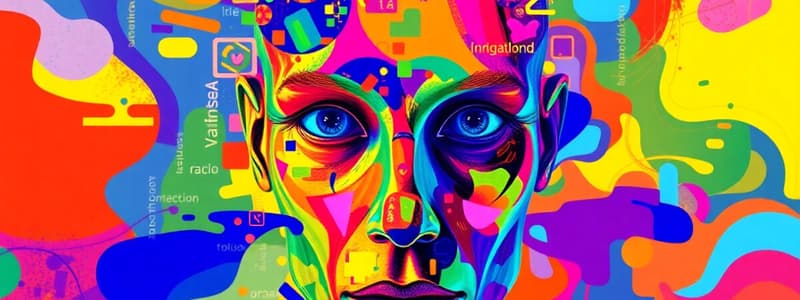Podcast
Questions and Answers
What are the two main topics covered in the agenda?
What are the two main topics covered in the agenda?
- Computer vision concepts and Convolutional neural networks
- Computer vision concepts and Machine learning
- Computer vision concepts and Computer vision capabilities in Azure (correct)
- Computer vision capabilities in Azure and Convolutional neural networks
What are the three learning objectives after completing the module?
What are the three learning objectives after completing the module?
- Understand the capabilities of Azure AI Vision, Identify the different services included in Azure AI Vision, and Describe the Face Detection service. (correct)
- Understand the capabilities of Azure AI Vision, Identify the different services included in Azure AI Vision, and Describe the OCR service.
- Understand the capabilities of Azure AI Vision, Identify the different services included in Azure AI Vision, and Describe the Object detection service.
- Identify the different services included in Azure AI Vision, Describe the Face Detection service, and Explain the differences between the Facial Recognition service and the Face Detection service.
An image is represented as an array of pixel values.
An image is represented as an array of pixel values.
True (A)
Filters are used to change images by applying a specific mathematical operation on individual pixels.
Filters are used to change images by applying a specific mathematical operation on individual pixels.
Convolutional Neural Networks (CNNs) use filter layers to extract features from images and analyze them to make predictions.
Convolutional Neural Networks (CNNs) use filter layers to extract features from images and analyze them to make predictions.
Multi-modal models are a newer approach to modeling, using multiple domains of data such as sound, images, and text.
Multi-modal models are a newer approach to modeling, using multiple domains of data such as sound, images, and text.
Which of these is NOT included in the Image Analysis capabilities of the Azure AI Vision service?
Which of these is NOT included in the Image Analysis capabilities of the Azure AI Vision service?
Which capabilities are included in Azure AI Vision's Face service?
Which capabilities are included in Azure AI Vision's Face service?
Which resource type should be used in Azure to access both Azure AI Vision and Azure AI Language services with a single key and endpoint?
Which resource type should be used in Azure to access both Azure AI Vision and Azure AI Language services with a single key and endpoint?
The following are capabilities of the Azure AI Vision service EXCEPT:
The following are capabilities of the Azure AI Vision service EXCEPT:
What is the URL for accessing the image analysis instructions on Learn?
What is the URL for accessing the image analysis instructions on Learn?
What is the URL for accessing the face detection instructions on Learn?
What is the URL for accessing the face detection instructions on Learn?
What is the URL for accessing the OCR instructions on Learn?
What is the URL for accessing the OCR instructions on Learn?
Which services are part of Azure AI Vision?
Which services are part of Azure AI Vision?
The Face service, within Azure AI Vision, provides access to facial recognition capabilities such as similarity matching and identity verification for all users.
The Face service, within Azure AI Vision, provides access to facial recognition capabilities such as similarity matching and identity verification for all users.
Flashcards
Computer Vision Concepts
Computer Vision Concepts
Computer vision involves using algorithms to interpret and understand images, similar to how humans process visual information.
Image Processing
Image Processing
Applying filters and transformations to images to enhance or change them.
Pixel Values
Pixel Values
Each tiny dot in digital images that includes data for color and intensity.
Convolutional Neural Networks (CNNs)
Convolutional Neural Networks (CNNs)
Signup and view all the flashcards
Filter Kernels (CNNs)
Filter Kernels (CNNs)
Signup and view all the flashcards
Multi-modal Models
Multi-modal Models
Signup and view all the flashcards
Azure AI Vision Service
Azure AI Vision Service
Signup and view all the flashcards
Image Analysis (Azure)
Image Analysis (Azure)
Signup and view all the flashcards
Azure AI Face Service
Azure AI Face Service
Signup and view all the flashcards
Optical Character Recognition (OCR)
Optical Character Recognition (OCR)
Signup and view all the flashcards
Face Detection
Face Detection
Signup and view all the flashcards
Facial Recognition
Facial Recognition
Signup and view all the flashcards
Study Notes
Microsoft Azure AI Fundamentals: Computer Vision
- This presentation covers Microsoft Azure AI Fundamentals: Computer Vision
- The agenda includes computer vision concepts and computer vision capabilities in Azure
- Learning objectives include understanding Azure AI Vision capabilities, identifying Azure AI Vision services, and describing face detection
Computer Vision Concepts
- Images are arrays of pixel values
- Filters are applied to images
Convolutional Neural Networks
- Labeled images are used to train the model
- Filter layers extract feature maps from each image
- Feature maps are flattened
- Feature values are fed into a fully connected neural network
- The output layer produces a probability value for each possible class label
- Filter kernels start with random weights during training
- Weights are adjusted to improve prediction accuracy
- The trained model uses learned weights to extract features from new images
Multi-modal Models
- Combine language and vision models to encode image and text data
- Encapsulates semantic relationships between image and text features
- Can be used as a foundation for more specialized models
Computer Vision Services in Azure
- Vision: Image Analysis (image tagging, captions, model customization), Optical Character Recognition (OCR), Spatial analysis
- Face: Face detection, Face recognition
Image Analysis 4.0 with the AI Vision Service
- Capabilities include model customization, reading text from images, detecting people and objects, generating image captions, tagging visual features, and smart cropping
Exercise: Analyze Images in Vision Studio
- Use the hosted environment and Azure credentials provided
- Instructions available on Learn at
https://aka.ms/ai900-image-analysis
Detecting Faces with the Face Service
- Detect faces, exposure, glasses, head pose, noise, occlusion
- Similarity matching and identity verification are available for managed Microsoft customers
Demo: Detect Faces in Vision Studio
- Demo exercise using Azure AI Face service
- Find exercise instructions at
https://aka.ms/ai900-face
Reading Text with Optical Character Recognition (OCR)
- Detect location and characters of printed/handwritten text
- Options for quick text extraction from images, or analysis of larger scanned documents
Demo: Read Text in Vision Studio
- Follow instructions at
https://aka.ms/ai900-ocrto use Azure AI Vision's OCR capabilities
Knowledge Check
- Question 1: Partially obscured faces cannot be identified
- Question 2: Create an Azure AI service
- Question 3: Face detection, OCR, and document intelligence are Azure AI Vision services
Studying That Suits You
Use AI to generate personalized quizzes and flashcards to suit your learning preferences.




